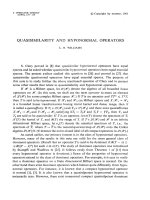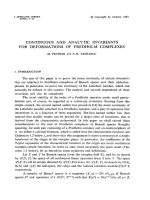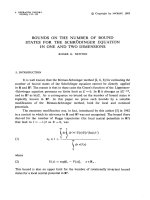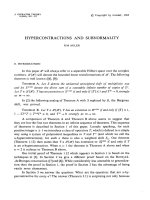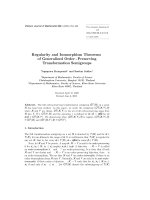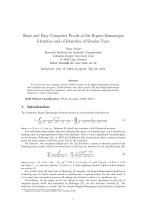Báo cáo toán học: "Paths and stability number in digraphs" pptx
Bạn đang xem bản rút gọn của tài liệu. Xem và tải ngay bản đầy đủ của tài liệu tại đây (83.6 KB, 4 trang )
Paths and stability number in digraphs
Jacob Fox
∗
Benny Sudakov
†
Submitted: May 15, 2009; Accepted: J ul 3, 2009; Publish ed : Jul 24, 2009
Mathematics Subject Classification: 05C20, 05C38, 05C55
Abstract
The Gallai-Milgram theorem says that the vertex set of any digraph with stabil-
ity number k can be partitioned into k directed paths. In 1990, Hahn and Jackson
conjectured that this theorem is best possible in the following strong sense. For each
positive integer k, there is a digraph D with stability number k such that deleting
the vertices of any k − 1 directed paths in D leaves a digraph with stability number
k. In this note, we prove this conjecture.
1 Introduction
The Gallai-Milgram theorem [7] states that the vertex set of any digraph with stability
number k can be par t itio ned into k directed paths. It generalizes Dilworth’s theorem [4]
that the size of a maximum antichain in a partially ordered set is equal to the minimum
number of chains needed to cover it. In 1990, Hahn and Jackson [8] conjectured that
this theorem is best possible in the following strong sense. For each positive integer
k, there is a digraph D with stability number k such that deleting the vertices of any
k − 1 directed paths in D leaves a digraph with stability number k. Hahn and Jackson
used known bounds on Ramsey numbers to verify their conjecture for k ≤ 3. Recently,
Bondy, Buchwalder, and Mercier [3] used lexicographic products of graphs to show that
the conjecture holds if k = 2
a
3
b
with a and b no nnegative integers. In this short note we
prove the conjecture of Hahn and Jackson f or all k.
Theorem 1 For each positive integer k, there is a digraph D with stability number k such
that deleting the vertices of any k − 1 directed paths leaves a digraph with stability number
k.
To prove this theorem we will need some properties of random gra phs. As usual, the
random graph G(n, p) is a graph on n labeled vertices in which each pair of vertices forms
an edge randomly and independently with probability p = p(n).
∗
Department of Mathematics, Princeton, Princeton, NJ. Email:
Research supported by an NSF Graduate Research Fellowship and a Princeton Centennial Fellowship.
†
Department of Mathema tics, UCLA, Los Angeles, CA 90095. Email:
Research supported in part by NSF CAREER award DMS-0812005 and by USA-Israeli BSF grant.
the electronic journal of combinatorics 16 (2009), #N23 1
Lemma 1 For k ≥ 3, the random graph G = G(n, p) with p = 20n
−2/k
and n ≥ 2
15k
2
a
multiple of 2k has the following properties.
(a) The expected number of cliques of size k + 1 in G is at most 20
(
k+1
2
)
.
(b) With probability more than
2
3
, every induced subgraph of G with
n
2k
vertices has a clique
of size k.
Proof: (a) Each subset of k + 1 vertices has pro bability p
(
k+1
2
)
of being a clique. By
linearity of expectatio n, the expected number of cliques of size k + 1 is
n
k + 1
p
(
k+1
2
)
=
n
k + 1
20
(
k+1
2
)
n
−k−1
≤ 20
(
k+1
2
)
.
(b) Let U be a set of
n
2k
vertices of G. We first g ive an upper bound on the probability
that U has no clique of size k. For each subset S ⊂ U with |S| = k, let B
S
be the event
that S forms a clique, and X
S
be the indicator random variable for B
S
. Since k ≥ 3, by
linearity of expectatio n, the expected number µ of cliques in U of size k is
µ = E
S
X
S
=
n
2k
k
p
(
k
2
)
≥
n
k
2(2k)
k
k!
20
(
k
2
)
n
1−k
≥ 2n.
Let ∆ =
Pr[B
S
∩ B
T
], where the sum is over all ordered pairs S, T with |S ∩ T| ≥ 2.
We have
∆ =
k−1
i=2
|S∩T |=i
Pr[B
S
∩ B
T
] =
k−1
i=2
|S∩T |=i
p
2
(
k
2
)
−
(
i
2
)
=
k−1
i=2
n
i
n − i
k − i
n − k
k − i
p
2
(
k
2
)
−
(
i
2
)
≤
k−1
i=2
n
2k− i
p
k(k−1)−
(
i
2
)
≤ 20
k
2
k−1
i=2
n
2−i+i(i−1)/k
≤ k20
k
2
n
2/k
.
Here we used the f act that i(i − 1)/k − i for 2 ≤ i ≤ k − 1 clearly achieves its maximum
when i = 2 or i = k − 1.
Using that k ≥ 3 and n ≥ 2
15k
2
, it is easy to check that ∆ ≤ n. Hence, by Janson’s
inequality (see, e.g., Theorem 8.11 of [2]) we can bound the probability that U does not
contain a clique of size k by Pr
∧
S
¯
B
S
≤ e
−µ+∆/2
≤ e
−n
. By the union bound, the
probability that there is a set o f
n
2k
vertices of G(n, p) which does not contain a clique of
size k is at most
n
n
2k
e
−n
≤ 2
n
e
−n
< 1/3. ✷
The proof of Theo r em 1 combines the idea of Hahn and Jackson of partitioning a
graph into maximum stable sets and orienting the g raph accordingly with Lemma 1 on
properties of random graphs.
Proof of Theorem 1. Let k ≥ 3 and n ≥ 2
15k
2
. By Markov’s inequality and Lemma
1(a), the probability that G(n, p) with p = 20n
−2/k
has a t most 2 · 20
(
k+1
2
)
cliques of size
k+1 is at least 1/ 2. Also, by Lemma 1(b), we have that with probability at least 2/3 every
set of
n
2k
vertices of this random graph contains a clique of size k. Hence, with positive
the electronic journal of combinatorics 16 (2009), #N23 2
probability (at least 1/6) the random graph G(n, p) has both properties. This implies
that there is a graph G on n vertices which conta ins at most 2 · 20
(
k+1
2
)
cliques of size
k + 1 and every set of
n
2k
vertices of G contains a clique of size k. Delete one vertex from
each clique of size k + 1 in G. The resulting gr aph G
′
has a t least n − 2 · 20
(
k+1
2
)
≥ 3n/4
vertices and no cliques of size k + 1. Next pull out vertex disjoint cliques of size k from G
′
until the remaining subgraph has no clique of size k, and let V
1
, . . . , V
t
be the vertex sets
of t hese disjoint cliques of size k. Since every induced subgraph of G of size at least
n
2k
contains a clique of size k, then |V
1
∪ . . . ∪V
t
| ≥
3n
4
−
n
2k
≥
n
2
. Define the digraph D on the
vertex set V
1
∪ . . . ∪ V
t
as follows. The edges of D are the nonedges of G. In particular,
all sets V
i
are stable sets in D. Moreover, all edges of D between V
i
and V
j
with i < j ar e
oriented from V
i
to V
j
. By construction, the stability numb er of D is equal to the clique
number of G
′
, namely k. Also any set of
n
2k
vertices of D contains a stable set of size k.
Note that every directed path in D has at most one vertex in each V
i
. Hence, deleting any
k − 1 directed paths in D leaves at least |D|/k ≥
n
2k
remaining vertices. These remaining
vertices contain a stable set o f size k, completing the proof. ✷
Remark. Note that in order to prove Theorem 1, we only needed to find a graph G on n
vertices with no clique of size k +1 such that every set of
n
2k
vertices of G contains a clique
of size k. The existence of such graphs was first proved by Erd˝os a nd Rogers [6], who more
generally asked to estimate the minimum t for which there is a gra ph G on n vertices with
no clique of size s such that every set of t vertices of G contains a clique of size r. Since
then a lot of work has been done on this question, see, e.g., [9, 1, 10, 5]. Although most
results for this problem rely on probabilistic arguments, Alon and Krivelevich [1] give an
explicit construction of an n-vertex graph G with no clique of size k + 1, such that every
subset of G of size n
1−ǫ
k
contains a k-clique. Since we only need a much weaker result
to prove the conjecture of Hahn and Jackson, we decided to include its very short a nd
simple proof to keep this note self-contained.
Acknowledgments. We would like to thank Adrian Bondy for stimulating discussions
and generously sharing his presentation slides. We also are grateful to Noga Alon for
drawing our attent io n to the paper [1]. Finally, we want to thank the referee for helpful
comments.
References
[1] N. Alon and M. Krivelevich, Constructive bounds for a Ramsey-type problem, Graphs
Combin. 13 (1997), 217–225.
[2] N. Alon and J. H. Spencer, The Probabilistic Method, 3rd ed., Wiley, 2008.
[3] J. A. Bondy, X. Buchwalder, and F. Mercier, Lexicographic products and a conjecture
of Hahn and Jackso n, SIAM J. Discrete Math. 23 (2009), 882–887.
[4] R. P. Dilworth, A decomposition theorem for partially o rdered set s, Ann. of Math.
51 (1950), 161 –166.
the electronic journal of combinatorics 16 (2009), #N23 3
[5] A. Dudek and V. R¨odl, On K
s
-free subgraphs in K
s+k
-free graphs and vertex Folkman
numbers, submitted.
[6] P. Erd˝os and C. A. Rogers, The construction of certain graphs, Can. J. Math. 14
(1962), 702–707.
[7] T. Gallai and A. N. Milgra m, Verallgemeinerung eines graphentheoretischen Satzes
von R´edei, Acta. Sci. Math. 21 (1960) 181–186.
[8] G. Hahn and B. Jackson, A note concerning paths and independence number in
digraphs, Discrete Math. 82 (1990), 327–329.
[9] M. Krivelevich, Bounding Ramsey numb ers through large deviation inequalities, Ran-
dom Structures Algorithms 7 (1995), 145–155.
[10] B. Sudakov, Large K
r
-free subgraphs in K
s
-free graphs and some other Ramsey-type
problems, Random Structures Algorithms 26 (2005), 253–265.
the electronic journal of combinatorics 16 (2009), #N23 4

